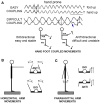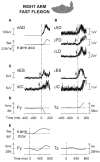APAs Constraints to Voluntary Movements: The Case for Limb Movements Coupling
- PMID: 28408875
- PMCID: PMC5374888
- DOI: 10.3389/fnhum.2017.00152
APAs Constraints to Voluntary Movements: The Case for Limb Movements Coupling
Abstract
When rhythmically moving two limbs in either the same or in opposite directions, one coupling mode meets constraints that are absent in the other mode. Isodirectional (ISO) flexion-extensions of the ipsilateral hand and foot can be easily performed with either the hand prone or supine. Instead, antidirectional (ANTI) movements require attentive effort and irresistibly tend to reverse into ISO when frequency increases. Experimental evidence indicates that the direction dependent easy-difficult dichotomy is caused by interference of the anticipatory postural commands associated to movements of one limb with voluntary commands to the other limb. Excitability of the resting wrist muscles is subliminally modulated at the period of ipsilateral foot oscillations, being phase-opposite in the antagonists and distributed so as to facilitate ISO and obstacle ANTI coupling of the hand (either prone or supine) with the foot. Modulation is driven by cortical signals dispatched to the forearm simultaneously with the voluntary commands moving the foot. If right foot oscillations are performed when standing on the left foot with the right hand touching a fixed support, the subliminal excitability modulation is replaced by overt contractions of forearm muscles conforming the APAs features. This suggests that during hand-foot ANTI coupling the voluntary commands to forearm muscles are contrasted by APAs commands of opposite sign linked to foot oscillations. Correlation between the easy-difficult dichotomy and the APAs distribution is also found in coupled adduction-abduction of the arms or hands in the transverse plane and in coupled flexion-extension of the arms in the parasagittal plane. In all these movements, APAs commands linked to the movement of each limb reach the motor pathways to the contralateral muscles homologous to the prime movers and can interfere during coupling with their voluntary activation. APAs are also generated in postural muscles of trunk and lower limbs and size-increase when the movement frequency is incremented. The related increase in postural effort apparently contributes in destabilizing the difficult coupling mode. Motor learning may rely upon more effective APAs. APAs and focal contraction are entangled within the same voluntary action. Yet, neural diseases may selectively impair APAs, which represent a potential target for rehabilitation.
Keywords: APAs; APAs destabilizing effects on coupling; coupled movements synchronization; direction principle; in phase and antiphase coupling; limb movements coupling; motor learning/training.
Figures













Similar articles
-
Postural adjustments in arm and leg muscles associated with isodirectional and antidirectional coupling of upper limb movements in the horizontal plane.Exp Brain Res. 2008 Sep;190(3):289-305. doi: 10.1007/s00221-008-1470-1. Epub 2008 Jul 2. Exp Brain Res. 2008. PMID: 18594800
-
The role of anticipatory postural adjustments in interlimb coordination of coupled arm movements in the parasagittal plane: II. Postural activities and coupling coordination during cyclic flexion-extension arm movements, ISO- and ANTI-directionally coupled.Exp Brain Res. 2013 Aug;229(2):203-19. doi: 10.1007/s00221-013-3605-2. Epub 2013 Jun 21. Exp Brain Res. 2013. PMID: 23793445
-
The role of anticipatory postural adjustments (APAs) in interlimb coordination of coupled arm movements in the parasagittal plane: I. APAs associated with fast discrete flexion and extension movements of one arm or of both arms ISO- and ANTI-directionally coupled.Exp Brain Res. 2013 Aug;228(4):527-39. doi: 10.1007/s00221-013-3584-3. Epub 2013 Jun 16. Exp Brain Res. 2013. PMID: 23771607 Clinical Trial.
-
The Organization and Control of Intra-Limb Anticipatory Postural Adjustments and Their Role in Movement Performance.Front Hum Neurosci. 2016 Oct 19;10:525. doi: 10.3389/fnhum.2016.00525. eCollection 2016. Front Hum Neurosci. 2016. PMID: 27807411 Free PMC article. Review.
-
Coupling of hand and foot voluntary oscillations in patients suffering cerebellar ataxia: different effect of lateral or medial lesions on coordination.Prog Brain Res. 2005;148:227-41. doi: 10.1016/S0079-6123(04)48019-4. Prog Brain Res. 2005. PMID: 15661194 Review.
Cited by
-
Fatigue may improve equally after balance and endurance training in multiple sclerosis: a randomised, crossover clinical trial.Front Neurol. 2024 Jan 19;15:1274809. doi: 10.3389/fneur.2024.1274809. eCollection 2024. Front Neurol. 2024. PMID: 38385033 Free PMC article.
-
The human voice aligns with whole-body kinetics.Proc Biol Sci. 2025 May;292(2047):20250160. doi: 10.1098/rspb.2025.0160. Epub 2025 May 21. Proc Biol Sci. 2025. PMID: 40393483
-
Three-dimensional path of the body centre of mass during walking in children: an index of neural maturation.Int J Rehabil Res. 2019 Jun;42(2):112-119. doi: 10.1097/MRR.0000000000000345. Int J Rehabil Res. 2019. PMID: 30882528 Free PMC article.
-
Reversed Mirror Therapy (REMIT) after Stroke-A Proof-of-Concept Study.Brain Sci. 2023 May 24;13(6):847. doi: 10.3390/brainsci13060847. Brain Sci. 2023. PMID: 37371327 Free PMC article.
References
-
- Babinski J. (1899). De l' asynergie cérébelleuse. Rev. Neurol. 7, 806–816.
Publication types
LinkOut - more resources
Full Text Sources
Other Literature Sources

